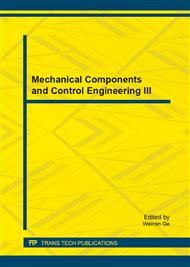p.160
p.164
p.168
p.172
p.176
p.181
p.185
p.189
p.193
Fatigue Life Prediction and Verification for HIC Hermetical Sealing under Random Vibration Loading
Abstract:
This work aims to predict fatigue life of hybrid integrated circuit (HIC) hermetical metal sealing structure mounted on PCB under random vibration loading. The prediction method consists of following steps. Firstly, finite-element model was developed to obtain model parameters (including natural frequencies and mode shapes) and power spectral density (PSD) of the critical part of sealing structure by ANSYS workbench. Secondly, modal test and random vibration test were conducted to verify the results of simulation. Thirdly, the Von Mises stress PSD was transformed into time-history data through inverse Fourier transform with Matlab program after calculating from the FEA results. The rainflow-counting algorithm was employed to evaluate cumulative damages of the critical part. The material’s S-N curve, Palmgren-Miner’s damage accumulation rule and rainflow-counting algorithm were used to predict fatigue life. A specially designed fixture and board with heat sink were used in the experiment to verify the first five mode shapes and response spectrum of the six critical points with hammer excitation. The calculation result of in this study is 70.3 hours which could be a reference for structural design of hybrid integrated circuit hermetical metal sealing under vibration conditions.
Info:
Periodical:
Pages:
176-180
Citation:
Online since:
October 2014
Authors:
Price:
Сopyright:
© 2014 Trans Tech Publications Ltd. All Rights Reserved
Share:
Citation:


